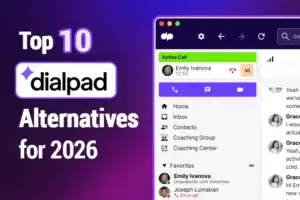Customers in 2022 expect to connect with your contact center via a variety of communication methods in a fluid, undifferentiated manner. As a result, it is becoming increasingly important to integrate the administration of contacts and provide advisers with easy access to the history of interactions with the client, independent of the channel.
Furthermore, to increase the efficiency and relevance of multi-channel request processing, you must assist your agents, as well as your clients, by providing them with a knowledge base. Ensuring consistency and uniformity in client responses across all channels (telephone, email, chat, mail, social networks…) reduces the number of exchanges required to complete requests. Which contributes to scaling up your business through customer satisfaction and loyalty.
Hence the question, how to create a unique knowledge base in 2022 for your contact center?
 Putting the customer at the top of your business instead of always having a monologue can make a big difference in how a customer feels about their journey. Jason Cutter, CEO of Cutter Consulting Group, an author, and a podcaster, thinks you can earn a customer’s trust by giving them knowledge and information about your company. From our podcast series, Stories of the Call Centers, Jason talks about how customer expectations have changed.
Putting the customer at the top of your business instead of always having a monologue can make a big difference in how a customer feels about their journey. Jason Cutter, CEO of Cutter Consulting Group, an author, and a podcaster, thinks you can earn a customer’s trust by giving them knowledge and information about your company. From our podcast series, Stories of the Call Centers, Jason talks about how customer expectations have changed.
A knowledge base: All the knowledge of a contact center
Did you know that 8. 51% of customers prefer technical support through a knowledge base? This serves as the organization’s only source of truth, feeding all interactions. It also makes the organization more intelligent and increases productivity, the quality of exchanges, and the autonomy and talents of the teams.
The health crisis has recently underscored the necessity for a knowledge foundation. In tumultuous times, when telecommuting is the norm, the knowledge base enables entire liberty for employees, independent of the company’s setting or structure.
All departments within the firm may require a knowledge base. The knowledge base is critical in all business areas, including sales, marketing, and support activities such as IT and HR. This is especially true in customer service, where day-to-day tasks include answering queries and analyzing potential client concerns.
In this situation, there are two sorts of knowledge bases: internal knowledge bases, which serve the company’s personnel, and external knowledge bases, which are immediately available to consumers allowing them to discover answers to their potential queries independently.
However, for a knowledge base to perform all of its duties, it is vital to understand how it is built and its secrets.
Knowledge at the cutting edge
The first stage is to conduct a thorough inventory of existing knowledge. It is essential to distinguish between already recorded information and undocumented knowledge. In the event of previously documented information, the following must be determined:
- The information that must be preserved
- The knowledge that will be withdrawn (obsolete or duplicated)
- The ability to edit or update
The work becomes more complicated when dealing with undocumented knowledge. This information exists in general, but it has not yet been cataloged. As a result, it is vital to locate and document it. Analyze the customer service department’s previous 1000 tickets. This sample is often fairly representative and should provide information on 80-90 percent of the customers’ demands. Interview customer service representatives. Experienced agents and managers who have witnessed the company’s growth and its procedures’ progress are frequently gold mines of information.
Creating the knowledge base
The preparation step can begin once the inventory has been completed. The key to a successful knowledge base is a clear understanding of the persona and purposes for whom it is meant. Then it would be best if you answered these questions:
- Is it a knowledge base for the staff or customers?
- What is the persona of the base user?
- What is the knowledge base’s purpose?
- What are the knowledge base’s objectives? For example, increase productivity, make onboarding easier, enhance referencing, and so on.
 Once this preliminary work is completed, the knowledge base structure may be determined. Again, several formats are conceivable, depending on the persona and its objectives: by question subject, by user type, by product, and so forth.
Once this preliminary work is completed, the knowledge base structure may be determined. Again, several formats are conceivable, depending on the persona and its objectives: by question subject, by user type, by product, and so forth.
The formats in which the knowledge will be transcribed must next be defined. Some will utilize text and graphics, while others will employ animations, videos, or even logical decision trees, depending on the intricacy of the subject to be communicated.
The final preparatory effort entails deciding on the style and feel of the future knowledge base. To preserve consistency over time, the tone of voice, graphic design, and writing style must all be specified and recorded.
Choosing the technology
Then comes the critical decision of which tool will house and make all of this knowledge available. Several options are available, including wikis, intranets, FAQs, and even dedicated knowledge base applications. Several major characteristics must be considered to decide on these numerous options:
- Hosting: CCaaS or on-premises software solution along with the knowledge editor’s power and ergonomics
- Format: the tool’s support for and acceptance of various content formats.
- Access: ease of access to the search engine’s knowledge and power.
- Dissemination: the capacity to spread knowledge through other technologies and automate content suggestions based on context.
- Monitoring tools: tools for assessing and measuring usage along with user’s performance.
Empower your agents and supervisors with Omnichannel! At NobelBiz, we believe that Across all communication channels, your contact center can deliver an intuitive and seamless customer experience for your clients.
Our Cloud Contact Center Solution NobelBiz Omni+, your agents to interact with your customers on their preferred communication channels (voice, web chat, email, SMS, and social media. You can anticipate your customers’ needs and bring customer experience excellence from the first interaction.
Many contact center experts have heard of the omnichannel strategy and have a working knowledge of what it entails. Few, however, have a firm grasp on how to monetise the omnichannel business model as a contact center. This webinar episode is intended for contact center executives who are transitioning from Voice to omnichannel technology. We’ll look at what it takes to establish an omnichannel solution and how it may help a contact center extend beyond its voice-only comfort zone.
The knowledge base structure
The process of establishing the knowledge base is generally dreaded due to its length. In actuality, as long as it is carefully managed and a proper knowledge base tool is used, this can be completed in a relatively short period. It is often broken into three stages:
- Migration: All current knowledge, whether dispersed or grouped in a single tool, must be transferred into the new tool of choice. Some knowledge base applications feature import modules that automate this time-consuming procedure.
- Creation: write the previously undocumented or non-existent knowledge from the first stage of this method (inventory).
- Review: screen the knowledge base and have some end users test it to find any missing material and confirm the ease of access to the knowledge.
Now that your knowledge foundation is complete! Your efforts should be focused on its rollout and user uptake.
A well-implemented knowledge base in your processes is required for a successful deployment. Some knowledge base tools provide plug-and-play connectivity with no effort on your part, in which case nothing could be simpler. If this is not the case, you will need to brief your IT staff on the business challenges for them to connect the knowledge base to the information system and all the tools to which it will be tied (ticketing, chat, telephony, website, etc.).
Implementation
In order to improve your contact center performance management. Once the deployment is complete, and the real-world tests have been done, it is time to move on to the critical step of change management, with the goal of having the new knowledge base embraced by the users. Several factors are required for practical adoption:
- Communication: communicate before installing the knowledge base to build enthusiasm and anticipation for the new tool and announce its implementation.
- Empowerment: educate each user on the value of the knowledge base on an individual and communal level.
- Best practices: Create “rituals” around the knowledge base, its use, and improvement.
- Reward system: Encourage the usage of the knowledge base and contributions to the content’s enhancement.
- Management: keep track of how the knowledge base is being used and how it evolves (adoption rate, frequency of use, time of use, etc.).
On-going enhancement
Obsolescence is the number one problem in knowledge base management. Nothing is more frustrating than a knowledge base with missing or outdated material. Here are some tips to avoid this and keep your knowledge base always updated with your users’ demands.
- Establish the proper processes: define the processes that control the knowledge base (managers, editing, verification, publication, announcement, etc.).
- Notify changes: notify the groups affected by changes in the structure of the knowledge base or content updates.
- Allow for user input to discover gaps, inadequacies, or misconceptions.
- Analyze the gaps: examine the keywords that were searched but were not located in the knowledge base to identify the material that needs to be developed.
- Additions are valued: accept and promote end-user contributions to the knowledge base to continually enrich it.
 With more than 20 years of experience being a carrier and a contact centercenter software provider. NobelBiz is the Promise Keepers of the industry! We are committed to offer the lowest cents per min rates, highest contact rates, anytime support, safety and a seamless customer experience.
With more than 20 years of experience being a carrier and a contact centercenter software provider. NobelBiz is the Promise Keepers of the industry! We are committed to offer the lowest cents per min rates, highest contact rates, anytime support, safety and a seamless customer experience.
With NobelBiz and you’ll get:
- World-Class Contact Center Software with fast implementation and excellent customer support for your contact center
- High-Quality Voice Service Network with low rates for call centers who want to give their customers the best there is.
- A Dedicated 24/7 support from our team of professionals. All dedicated to your business success.

Abdelmounim Benharouga has always had a strong passion for writing and digital marketing. He started as a Digital Content Writer part of marketing department then moved to being Customer Success Manager for the African Region within the Nobelbiz team.







